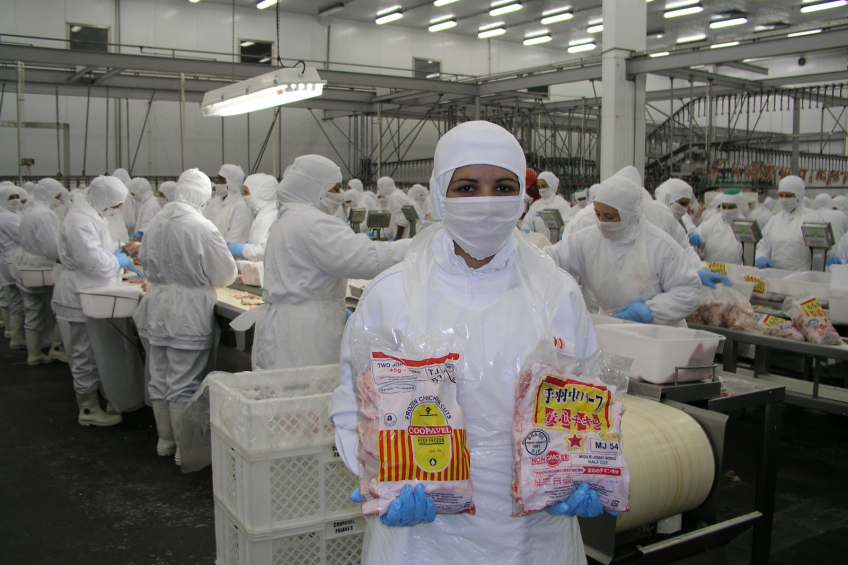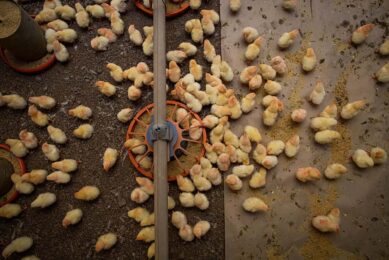Brazil ups poultry exports at the cost of the US

Countries that temporarily embargoed poultry meat from US regions are happily supplied by Brazilian exporters.
Avian influenza severely hit the egg producing industry in the US, yet the outbreak scarred the poultry meat business as well. Meat export embargoes, although regional in nature, caused a decline in total exports. Producers from Brazil upped their exports to fill the gaps.
Following the spring outbreak of avian influenza in the US, it is time to take an inventory on the damage done. Although broiler farms have not been affected, the flocks of laying birds and turkeys have suffered gravely. The egg market has faced shortages, pushing up prices to record highs in August as a dozen eggs approached US$3; an increase of 135% from the previous year. The replenishment of the laying flock has not gone as fast as the one for chickens used in broiler production, which could keep this market down for the entire second semester. According to projections made by the United States Department of Agriculture (USDA) published in August 2015, American egg production will decrease by 4% this year, rebounding to grow by 2% in 2016. Turkey production, on the other hand, is projected to decrease by 2% this year, followed by a recovery of 7% growth next year.
Regional embargoes
In poultry meat production, embargoes on American chicken meat increased as flu cases increased, but these embargoes were more regional in nature. This fact helped the industry avoid a sharp decline in exports, but it still had some consequences. Foreign sales of chicken from the US during the first six months of 2015 declined by 9.4% or 189 thousand tonnes. Yet not everything can be attributed exclusively to the recent embargoes. Russia, for example, banned imports of US products as of September 2014, while China has been buying insignificant volumes since January 2015. With record results having been set for Brazilian chicken meat exports since June, it is possible to conclude that Brazil is already taking advantage of the gap left by lower North American sales. As Brazil published excellent export volumes after news of the avian flu and embargoes in the US broke, the impression left was that the correlation between the events (record exports from Brazil and US market closures) was very high.
Despite this, an analysis of the American and Brazilian poultry trade up to June (latest data available in the US) showed that the growth of Brazilian exports in this period could be attributed to only 30% of the decline observed in the US. In terms of tonnage, while the US exported 189 thousand tonnes less in the first six months of 2015, Brazil increased its exports by only 57 thousand tonnes in the same period. And the growth of Brazilian sales to Russia, from 66% in the comparative Jan-Jun 2014/15 period, amounted to 15 thousand tonnes, which is barely 12% of the volume that the US stopped supplying to Russia. Growth in Brazil’s exports to China was 44% of the amount not sent by US (a rise of 39 thousand tonnes for Brazil vs a decrease of 89 thousand tonnes for the US.) Of course, we should use a longer period of time for the comparison to draw accurate conclusions on Brazil’s gain in this atypical situation for American poultry. That said, Brazilian exports established a new record at the end of July, even higher than the previous month.
Export forecast not optimistic
According to the USDA, the American production of chicken meat is expected to grow by 4.4% this year, exceeding 18 million tonnes, and by an additional 2.8% in 2016. On the export front, the figures are less optimistic: this year exports are expected to decrease by 6.3%, but are expected to recover by 5.4% next year. This suggests that the window opportunity for current Brazilian exports will close, although the tendency of the US dollar to appreciate against other currencies will reduce the competitiveness of the country on the export market in the near future.
Jaguafrangos chicken processing plant employees working on the poultry export line in Londrina, Parana, southern Brazil. Photo: ANP
Data on the production of hatching eggs and chickens’ in the US in recent weeks have already begun to point to a much more modest growth compared with the same time the previous year, around 0.5% vs increases of 3.0% a few weeks ago. Yet the wholesale price of American chicken meat was only 2% lower than the price in December 2014 and continues to be far from the minimum in December 2013, which is associated with the USDA forecast. Interestingly, unlike other past outbreaks of avian flu in Asia, there was no decrease in the consumption of chicken meat by Americans. On the contrary, per capita consumption should grow by 6.0% this year in the US. Some reasons for this are the absence of related human deaths at this time and the confidence Americans have in controls, hatcheries and mainly in commercialisation, which is much safer in relation to live bird markets in Asia.
Higher prices across the board
In Brazil there has been a significant increase in domestic prices for chicken since the start of June, both living and slaughtered. Prices increased by almost 20% in this period. The excessive internal supply up to May, which was up by 15% from May 2014, dropped by more than 5% in June as shipments overseas dried up the domestic market. The higher price levels in the poultry market are also linked to worsening inflation in the country, coupled with other deteriorating economic indicators, such as employment, which has surely contributed to a decline in beef consumption in favour of chicken meat. Although paradoxically, the worse the situation for Brazilian consumers is, the higher the demand for chicken meat tends to be. The low supply of livestock due to the period between harvest and the retention of cattle should also boost beef and, simultaneously, chicken. So, from the perspective of demand, prospects continue to be very positive. Yet it should be noted that even with the rising prices of chicken meat, the margin of poultry has not increased as systematically as it did in the second half of last year when the price increase was accompanied by a reduction in costs. This time, pressure on costs, which began this year with energy and labour costs, has now also affected feed, as the drop in exchange rate value of the Real has placed pressure on the price of feed ingredients. On one hand, the absence of climate issues this year ensured an excellent result, mainly during the second harvest, which is relatively positive in terms of supply. On the other, excessive financial and political problems should keep pressure on exchange rates, which will prevent a drop in the poultry costs curve.
MBAgro
Founded by José Roberto Mendonça de Barros and Luiz Carlos Mendonça de Barros, ‘MB Associados’ provides consulting services in areas like macro-economic and sectoral analysis, as well as economic development forecasts, both short-term and long-term scenarios designed for companies, banks and Brazilian associations. The role of Agribusiness has always been highlighted at ‘MB Associados’. With a growing interest in this important economic sector, MB Agro emerged in 2005 as an independent consulting company entirely focused on assisting the agricultural industry.
Join 31,000+ subscribers
Subscribe to our newsletter to stay updated about all the need-to-know content in the poultry sector, three times a week. Beheer
Beheer








 WP Admin
WP Admin  Bewerk bericht
Bewerk bericht